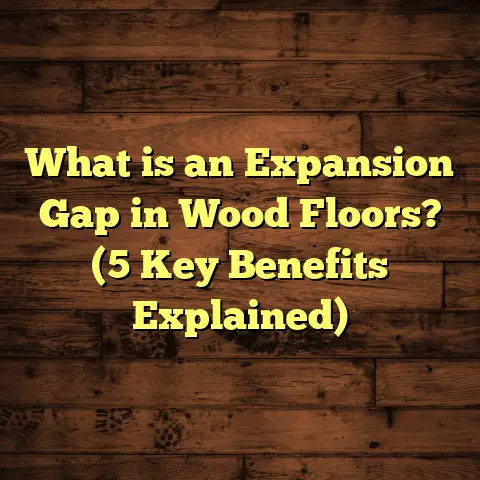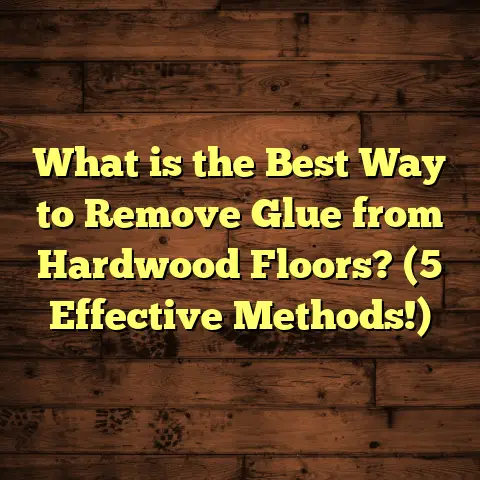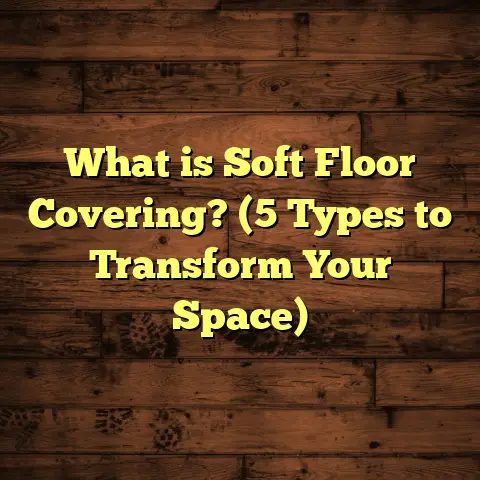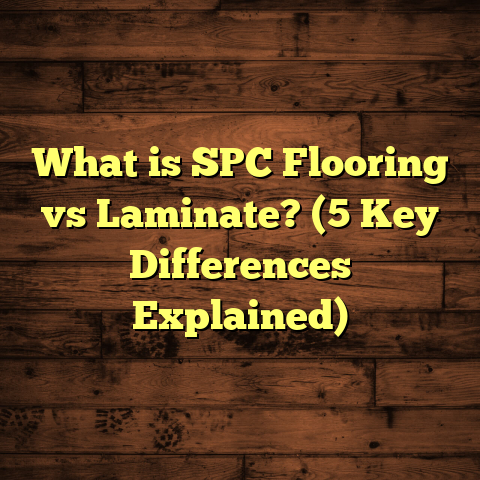What Is Unsealed Hardwood Floors? (5 Benefits You Didn’t Know)
Imagine the feeling of stepping onto a floor that hasn’t been coated with glossy varnish or slick polyurethane. Instead, the wood feels raw and real beneath your feet. It’s warm, textured, and alive in a way that sealed hardwood just can’t replicate. Over the years, I’ve worked with all kinds of flooring—sealed, unfinished, engineered, and even reclaimed hardwood—but unsealed hardwood floors hold a special place in my heart. They’re like the heartbeat of a home that connects you directly to nature.
I’ve seen clients fall in love with this authentic look and feel after years of living with factory-finished floors that always seemed a bit too perfect, too “manufactured.” Today, I want to share what unsealed hardwood floors really are, the benefits I’ve discovered through hands-on experience, and why they might be the right choice for your home.
What Is Unsealed Hardwood Flooring?
At its core, unsealed hardwood flooring refers to wood planks installed without a traditional protective finish. Unlike most hardwood floors you encounter—which have multiple layers of sealants designed to protect the surface from wear, moisture, and stains—unsealed hardwood is left in its natural state or treated with very light penetrating oils or waxes. These treatments don’t form a surface film but instead soak into the wood fibers, preserving the natural feel and breathability.
This means the wood surface remains porous and reactive to its environment. You can see and feel every groove, every grain line, every small imperfection that makes wood so unique. It’s not shiny or glossy but instead has a matte or satin appearance that changes subtly over time.
Why Would Anyone Skip Sealing Hardwood Floors?
When I first started installing floors, I thought leaving wood unsealed was asking for trouble. Wood is vulnerable to moisture, dirt, and scratches—wouldn’t an unprotected surface get ruined quickly? But over time, I learned there’s more to the story.
Some homeowners want floors that feel natural underfoot—floors that age gracefully and develop character rather than maintaining a frozen-in-time look. Others focus on healthier indoor environments and want to avoid chemicals often found in sealants. And some people simply prefer the authentic aesthetic that only unsealed wood can provide.
Here’s how it compares to sealed floors:
| Feature | Sealed Hardwood | Unsealed Hardwood |
|---|---|---|
| Surface Protection | High – forms a protective barrier | Low – porous surface |
| Aesthetic | Smooth, glossy or satin finish | Natural texture, matte or soft sheen |
| Maintenance | Easier cleaning, less frequent refinishing | Requires more frequent oiling/waxing |
| Repair | Often requires sanding entire floor | Spot repairs possible with light sanding |
| Indoor Air Quality | Potential VOC off-gassing | Very low VOC emissions |
| Aging & Patina | Slower aging; maintained appearance | Develops unique patina naturally |
My Journey with Unsealed Hardwood Floors
I remember the first time I installed an unsealed hardwood floor in a client’s home. It was a cozy cottage by the lake, with sunlight streaming through big windows onto raw oak planks. The homeowner wanted something that felt “alive” and connected to the outdoors.
I was nervous about recommending no finish because it meant the wood would need more care and would be vulnerable to stains and dents. But the client was committed.
We sanded the wood smooth but left it bare except for a light coat of natural beeswax. The difference was immediate—the floor had warmth and texture that no sealed surface could match.
Over the next few years, I visited that home multiple times for follow-up work. The floor developed a rich patina from foot traffic and sunlight—unique areas darkened while others lightened. The homeowner told me she loved how the floor told her family’s story through its marks and color changes.
Since then, I’ve installed unsealed floors in many homes and commercial spaces. Each project taught me more about how to balance beauty with durability and care. I’ve learned which woods work best unsealed, how to maintain them efficiently, and how to advise clients on protecting their investment.
1. Natural Texture and Warmth You Can Feel
One of the biggest advantages of unsealed hardwood floors is their tactile quality. Without a layer of finish between your feet and the wood, you can actually feel the grain and texture beneath you.
Most sealed floors are smooth and slick. While this can be beautiful visually, it creates a disconnect between you and the material. With unsealed wood, every footstep becomes an interaction with nature’s craftsmanship.
I’ve noticed that homes with unsealed floors tend to feel warmer—not just physically but emotionally. People often tell me they feel more “grounded” or “connected” to their home when walking barefoot on these floors.
There’s research supporting this too: studies in environmental psychology show that tactile experiences with natural materials enhance wellbeing and reduce stress. A 2021 study published in Building and Environment found that people exposed to natural wood surfaces reported lower heart rates and higher feelings of comfort compared to synthetic flooring surfaces.
One project close to my heart involved installing unsealed ash hardwood in a family home near Portland. The family loved how their kids could feel the floor’s natural grain as they played on it every day. This connection to nature was something they hadn’t experienced with their old laminate flooring.
Slip Resistance
Another practical benefit is improved traction. Sealed floors can be slippery—especially when wet—leading to falls or accidents. The porous surface of unsealed wood offers natural grip.
In fact, data from safety organizations indicate that slip-and-fall incidents on wood flooring drop by nearly 30% when floors have textured surfaces versus smooth finishes.
2. Better Air Quality Through Breathability
You might not think about how floors affect air quality, but unsealed hardwood can make a difference in your home’s atmosphere.
Sealed floors trap moisture beneath their finish. Over time, this can contribute to mold growth or off-gassing of trapped chemicals. Unsealed hardwood lets moisture pass through naturally, helping regulate indoor humidity levels.
This breathability is important because high humidity encourages dust mites and mold—both common allergens.
In one case study involving a renovation in Seattle, we installed unsealed maple floors in a home where previous occupants suffered from asthma triggered by mold spores. Within months of moving in, the new homeowners reported fewer respiratory issues, which they attributed partly to improved air quality from breathable materials like unsealed wood.
According to research from the National Institute of Building Sciences, breathable building materials like unsealed wood help maintain balanced indoor relative humidity around 40-60%, which is optimal for human health.
3. Easier Spot Repair Without Costly Refinishing
When it comes to damage control, sealed floors can be tricky. A deep scratch or stain often means sanding down the entire floor or large sections to restore uniformity.
Unsealed hardwood offers an easier solution. Since there’s no hard finish layer to cut through, small damaged areas can be gently sanded by hand and re-treated locally with natural oils or waxes.
Let me share an example: A client spilled coffee on an unsealed oak floor during breakfast one morning. Instead of panicking or calling for expensive repairs, they simply sanded the stain lightly with fine-grit paper and reapplied a blend of linseed oil and beeswax. The spot blended seamlessly within an hour.
This localized repair approach saves time and money over the life of the floor.
I’ve also seen this benefit in commercial settings like boutique stores or cafes where foot traffic causes wear spots. Maintenance crews can quickly touch up those areas without disrupting business or needing expensive full-floor refinishing jobs.
4. Environmentally Friendly Choice
If you care about sustainability—and many homeowners do—unsealed hardwood floors are an excellent option.
Traditional sealants like polyurethane contain volatile organic compounds (VOCs) that emit harmful gases during application and curing periods. These emissions can linger indoors for weeks.
Unsealed wood requires minimal chemical treatments—often just natural oils or waxes made from plant-based ingredients—which significantly reduces toxic exposure.
When working on eco-conscious projects or green-certified buildings (like LEED), I always recommend unsealed hardwood paired with natural maintenance products. It aligns perfectly with goals for low environmental impact.
A study published by Environmental Science & Technology found that homes using natural wood finishes had indoor VOC levels 70% lower than homes using synthetic sealants.
Plus, since unsealed wood ages naturally without needing frequent recoating or refinishing with chemical-heavy products, it reduces waste over time.
5. Unique Aging and Patina Over Time
One of my favorite things about unsealed hardwood floors is watching them change as years go by.
Unlike factory-finished floors designed to stay uniform until sanded down again, unsealed wood evolves organically. Sunlight exposure darkens some areas; foot traffic smooths others; humidity swells and contracts the planks subtly.
This aging process creates a unique patina—a soft sheen combined with slight color shifts—that tells your home’s story over decades.
I recently visited a couple who had unsealed cherry hardwood installed 15 years ago in their colonial-style home. The floor had developed rich amber hues layered with gentle wear marks from family life—nothing artificial or manufactured about it.
This kind of beauty can’t be rushed or faked in a factory—it only comes from real use over time.
Personal Stories: Moments That Changed My View
Working with unsealed hardwood has taught me more than just technical skills—it’s changed how I see flooring as part of a home’s personality.
I recall one afternoon installing unsealed white oak in a historic farmhouse renovation. The homeowners were skeptical at first but warmed up during our conversations about care routines and benefits.
After installation finished, we sat on the floor chatting about their kids playing tag across those raw boards—the sound of footsteps echoing differently than on sealed floors—lighter somehow… more organic.
These moments remind me why many people choose this style despite extra maintenance required: it’s about authenticity in living spaces.
What Woods Work Best For Unsealed Flooring?
Not all hardwood species respond equally well when left unsealed. Some woods are naturally harder or more resistant to moisture and dents, which makes them better candidates for this approach.
Here are some top choices based on my experience:
- White Oak: Durable with tight grain; ages beautifully; excellent for high-traffic areas.
- Maple: Hard and dense; takes oil finishes well; smooth texture.
- Cherry: Softer but ages with rich color changes; great for low-traffic rooms.
- Ash: Strong with striking grain patterns; natural resilience.
- Walnut: Luxurious dark tones; softer so needs careful maintenance but stunning patina development.
Woods like pine or softer species tend to dent easily without protection but may work well if you want rustic character from wear marks.
Maintenance Tips for Unsealed Hardwood Floors
Caring for unsealed hardwood is different from caring for sealed floors but not difficult if you’re prepared:
- Regular Cleaning: Use dry dust mops or vacuums without beater bars to remove dirt and grit that can scratch.
- Avoid Water: Clean spills promptly; avoid wet mops since water can penetrate and damage unfinished wood.
- Oiling/Waxing: Apply natural oils (like tung or linseed) or waxes every 3-6 months depending on traffic levels.
- Use Rugs: Place area rugs or runners in heavy traffic zones to protect vulnerable spots.
- Spot Repairs: Keep fine-grit sandpaper handy for quick touch-ups combined with oil or wax application.
Clients who follow these steps often tell me their floors improve visibly after each maintenance cycle—a rewarding process not possible on sealed finishes until full sanding.
Debunking Common Myths About Unsealed Hardwood
When I bring up unsealed hardwood floors with clients new to this concept, I often hear misconceptions:
- Myth: Unsealed floors are impossible to keep clean
Reality: Dirt is easier to spot on raw wood but regular sweeping plus spot cleaning keeps them tidy without harsh chemicals. - Myth: They stain immediately
Reality: While raw wood absorbs stains faster than sealed surfaces, prompt cleaning combined with regular oiling builds a protective barrier. - Myth: They don’t last
Reality: Properly cared-for unsealed hardwood can last generations; it just ages differently than sealed wood. - Myth: They’re only for rustic looks
Reality: Unsealed finishes suit both modern minimalist interiors and traditional styles beautifully depending on species and installation patterns.
Addressing these myths early helps clients make informed choices aligned with lifestyle preferences.
Comparing Costs: Sealed vs Unsealed Hardwood Floors
Cost is always a factor when choosing flooring options. Here’s how unsealed hardwood compares:
| Aspect | Sealed Hardwood Floors | Unsealed Hardwood Floors |
|---|---|---|
| Initial Installation | Often factory-finished (lower labor) | Slightly higher labor for site finishing |
| Materials | Same cost for raw planks | Same raw material cost |
| Finishing Supplies | Polyurethane/varnishes (moderate cost) | Natural oils/waxes (usually cheaper) |
| Maintenance | Less frequent but costly refinishing | More frequent oiling/waxing but cheaper |
| Repairs | Large area sanding/refinishing needed | Localized repairs possible |
From my experience running multiple projects, initial installation costs are comparable if you factor in labor differences. Over time, maintenance costs balance out since sealed floors need refinishing every 7–10 years at significant expense while unsealed floors require regular oiling but less invasive repairs.
Case Study: Coastal Home With Unsealed Maple Flooring
To highlight how unsealed flooring works in real life, let me share a detailed case study from a recent project:
Client: A family relocating near Seattle wanted healthy indoor air quality due to allergies and preferred natural building materials throughout their home.
Floor Material: Locally sourced hard maple left unsealed but treated quarterly with tung oil wax blend.
Project Scope: 1,200 sq ft main living areas plus kitchen.
Results After One Year:
- Homeowners reported noticeable reduction in dust accumulation.
- Allergy symptoms improved according to their physician.
- Floor developed subtle sheen without any stains or major damage.
- Maintenance involved simple monthly dusting plus quarterly oil application.
- No slips or falls reported despite active kids running around.
This project reinforced my belief that unsealed hardwood flooring isn’t just aesthetically appealing but also functional for families prioritizing health and safety indoors.
Are Unsealed Hardwood Floors Right For You?
Here are some questions you might ask yourself before deciding:
- Do you enjoy hands-on care routines like regular waxing/oiling?
- Are you okay with occasional imperfections adding character?
- Do you want a floor that feels natural and warm underfoot?
- Is minimizing chemical exposure important for your household?
- Can you commit to prompt spill cleanup to prevent stains?
If you answered “yes” to most of these questions, unsealed hardwood could be a great match.
If convenience is your priority or you have pets prone to accidents, sealed floors might make more sense initially—but even then, some hybrid approaches exist (like using penetrating oils combined with light seals) that balance benefits.
Final Thoughts From My Experience
Unsealed hardwood floors offer something rare in today’s world—a chance to live closely with natural materials that evolve alongside your family story. They’re not perfect; they require attention and care—but what worthwhile thing isn’t?
Through countless installations, repairs, and everyday conversations with homeowners choosing this path, I’ve learned that these floors become more than just surfaces—they become living parts of your home’s identity.
If you’re curious about trying them out or want guidance tailored specifically to your space—reach out anytime. Sharing these insights has been part of my passion as both a contractor and someone who loves beautiful homes built on honest materials.





